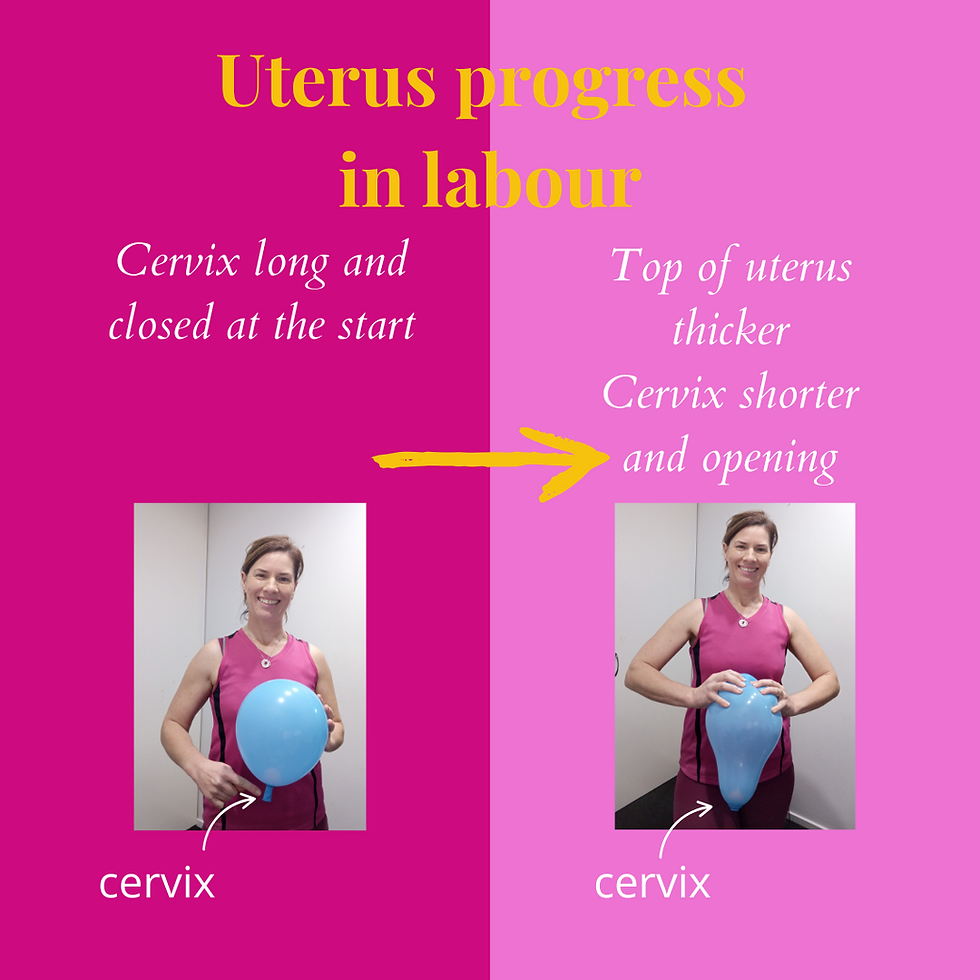Move with Purpose: Creating Space for a Positive Birth Experience
- Jo

- Aug 7
- 7 min read
Although we know your body was built to birth the unpredictability of birth, let alone the concept of not knowing what you don’t know comes into play. But here’s the truth: preparation matters. When you understand how your body works during labour, how your uterus, your pelvis and your pelvic floor muscles move with purpose, you empower yourself with the ability to intentionally prepare your body for a confident positive birth experience.

I know from both my own experience of a game changing third pregnancy and also through supporting others in their birth prep journey, when you have an understanding of what your body is working extremely hard to achieve during labour, you tend to cope better, your hormones align better, tension throughout your body is less and the labour process flows better. When your body is prepared for the movement and has the ability to create the space that your baby needs to pass through your birth canal (pelvis and pelvic floor muscles) with ease then labour will be easier and progress smoother with less injury to this area.
I know that fear is playing on your mind, and I intend to ease that through education and inspiration to support you to prepare you better for labour.
Here are my four essential tips to aid preparing your body for a confident labour and birth experience.
Understand the labour and birth process for a positive birth experience
Understand the process your body is going through for labour to progress.
When you empower yourself with the understanding of what your body, your uterus and your pelvis are working to achieve during the intensity of each contraction, you arm yourself with the awareness that the pain or intense sensation that you will feel with each regular contraction is for a purpose.
We all know that during labour and birth Mum’s go through a series of intense contractions, they will likely be extremely painful and hard to tolerate, you will likely spend a lot of time worrying or figuring out how you will manage this pain which is understandable and there are a lot of options. Here’s a great place to start. Think about understanding and visualising what your body is doing with each contraction, the uterus slowly building thickness and strength up to its top to thin and open your cervix at the bottom.

You can work through that vision to help with this process rather than tense up to potentially hinder it.
Practicing for the endurance you will need for labour as the contractions build in intensity and become closer and closer together is a great tool to prepare you for this. Try this circuit aimed at keeping your mindset on task for about 1 minute at a time, which is roughly how long contractions will last at the most intense part of your labour. These will keep coming every 2-3 minutes, sometimes with very little break.
Preparation through movement
Practise moving your body in ways that will create space for your baby to be in the optimal position for labour to start and progress. Movement creates space, you need space for optimal positioning of the baby but also space and the ability of your pelvis to move subtly to open at the top, through the mid pelvis and open at the bottom as your baby rotates through and is born.
The position that your baby is in inside your uterus is significant in determining how your labour may progress. A consideration to support optimal positioning includes posture awareness; throughout your pregnancy, your posture changes significantly, your centre of gravity is thrown off as your baby grows out the front and the rest of your body compensates for that, creating tension in all sorts of places.
Ligaments surrounding your uterus can build up tension that may impact your baby's positioning and potential your comfort with everyday activities. Having body awareness of how you stand, sit and move regularly and a toolbox of exercises to practise regularly to help keep tension even throughout your body will support your baby to find and maintain balance and space within your womb for optimal labour progression.
Additionally, having the understanding and ability of your pelvis to move in the subtle ways and the ability of your pelvic floor muscles to yield and stretch with ease will support the progress and outcomes of your labour. Pelvic mobility will help to enable your baby to engage into the top of your pelvis and the progression of your labour as your baby moves down and rotates through and out the bottom without getting stuck or causing nasty tears to your perineum/pelvic floor muscles.
This leads on to understanding the part your pelvic floor muscles play in your labour.
Your pelvic floor muscles
Do you even know much about your pelvic floor?

Your pelvic floor is the sling of muscles that sit within your pelvis attaching from front to back and side to side. Your pelvic floor muscles make up the bottom of your core system, they literally hold your abdominal organs in (your bladder, uterus and bowel) and control your toileting functions. During labour and birth, these muscles get stretched to 300-400 times their normal length, sometimes getting injured in the process, anything from small grazes to deep and nasty tears that may effect your toileting function afterbirth, this is something I’m extremely passionate about supporting you to prevent having suffered a nasty tear and subsequent problems with leaking ever since. I’m constantly shocked in my work as a maternity nurse hearing that Mum’s don’t know much about their pelvic floor muscles after giving birth. Preparation for birth with a good understanding of these muscles and practising ways to connect with and relax/lengthen these muscles for birth will help reduce your risk of injury. Grab your free pelvic floor protection guide here
After birth, it is essential to take time to proactively and intentionally rehab your body, just like you would any other significant injury. Pregnancy, labour and birth impact your body significantly, you shouldn’t be expected to return to normal activities and function after giving birth or even at six weeks, you need to reconnect with and strengthen your pelvic floor muscles in coordination with your entire core system so that your body will function well for life. Without proper guidance you may end up suffering from pelvic floor and core symptoms such as your pelvic floor muscles letting you down with leaking, pain or symptoms of pelvic organ prolapse or suffering other core related injuries like back pains because your core isn’t functioning optimally.
You can follow my Re-energised Postnatal Recovery Program online here.
Your birth team and environment
Recruit a team (especially your birth partner) and environment that is going to facilitate you to feel the most safe and comfortable to allow the natural progression of labour. Don’t underestimate the power of hormones!
Hormones play a significant role in your labour progression, ideally you will want your oxytocin (your love hormones) to be at their peak, I mean you are about to meet your baby(s), one of the most important and treasured people in your life. Yes it might be a pretty scary time too, and lots of other hormones like adrenaline might creep in too. The goal is to prepare yourself, your support crew and your environment to keep the pesky adrenaline and fear away and keep your love and safety hormones flowing, this helps your uterus open up your cervix.
Planning your environment will help with this, think about what sounds, sights, smells, touches make you feel comfortable, happy and safe, plan to recreate this during your labour - make sure your birth partner knows what to prepare, support you to achieve.
Think about the environment (if this is within your control ie low risk pregnancy planning for spontaneous labour and birth) where will you feel most safe to labour, think about if you would like to travel to a local birth centre or hospital, what do you take with you, keep the sounds/smells going the best you can during the journey.
Are there some massage techniques your partner can do for you to keep you relaxed, keep the tension out of your shoulders, hips and pelvic floor muscles. Did you know your jaw is connected to your pelvic floor muscles? If your jaw is tense, it is likely your pelvic floor muscles will be too.
For best results, don’t just have awareness of these strategies, actually practise them regularly with your birth partner, so that when the time comes, your body is familiar, confident and comfortable with the movement required to create space, release tension and birth your baby with ease. Labour can be likened to a marathon, would you rock up to a marathon without having prepared for it first? Not likely, it’s not just about fitness and movement is about the mindset and resilience for the endurance required. Enabling you with some tools, guidance through practising movement to create the space to facilitate achieving the smooth and positive birth experience you hope for.
Intentional preparation will help reduce your anxiety and fears around your pending birth and help you and your birth partner build trust and confidence in the process. Preparing your mind and body, as well as including your partner in this preparation will set you up for an empowering journey through your labour together.
All of these aspects with a deeper focus on guiding through pelvic mobility and pelvic floor relaxation are available inside my online PREPARE labour and birth prep program. A program I have designed to be accessible, affordable and achievable for all pregnant Mums, the information I wish I had had as a first and second time Mum who sustained a nasty tear, and required an episiotomy. I was so grateful to have this knowledge and tools to prepare for my third birth which was such a better experience where I subsequently didn’t require intervention or sustain any birth injuries. I want this for you and all Mums, you deserve this.





Комментарии